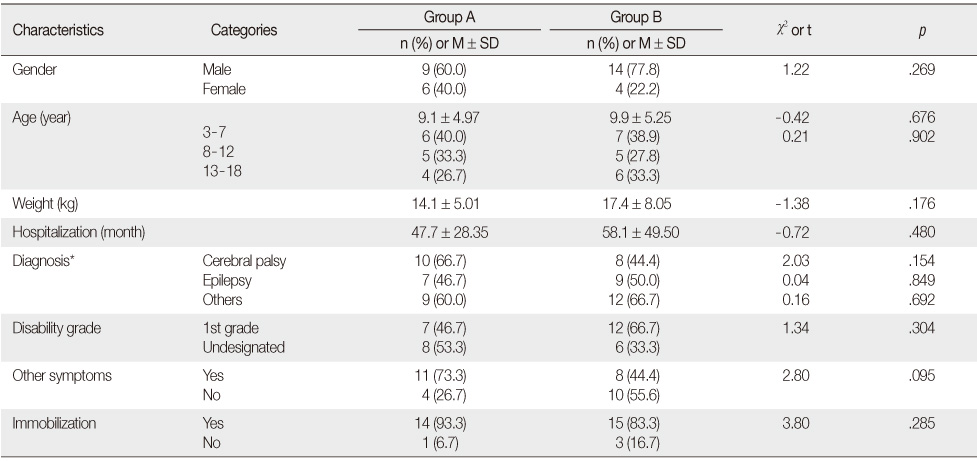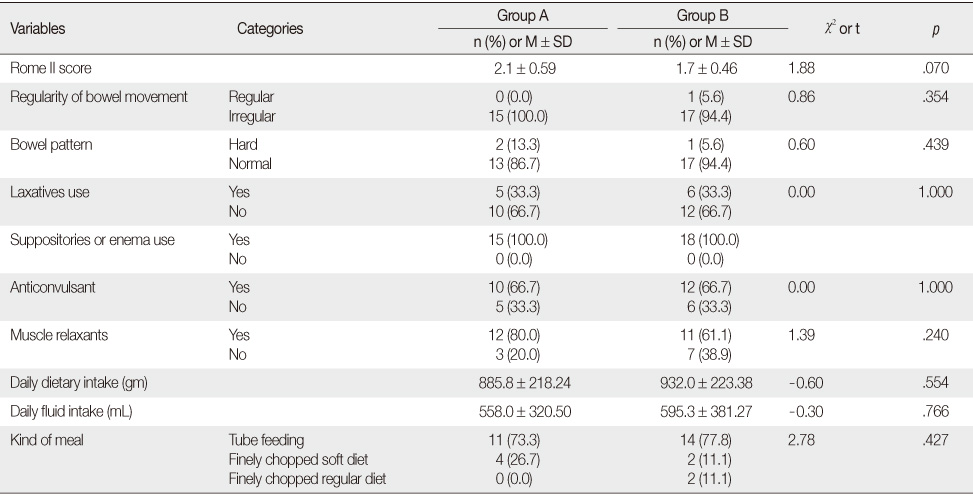Articles
- Page Path
- HOME > J Korean Acad Nurs > Volume 43(2); 2013 > Article
-
Original Article
- Effects of Abdominal Meridian Massage with Aroma Oils on Relief of Constipation among Hospitalized Children with Brain related Disabilities
- Mi Jung Nam, Young Ie Bang, Tae Im Kim
-
Journal of Korean Academy of Nursing 2013;43(2):247-255.
DOI: https://doi.org/10.4040/jkan.2013.43.2.247
Published online: April 30, 2013
1Department of Nursing, Daejeon Health Science College, Daejeon, Korea.
2Nursing Department, Seoul Metropolitan Children's Hospital, Seoul, Korea.
3Department of Nursing, Daejeon University, Daejeon, Korea.
- Address reprint requests to: Kim, Tae Im. Department of Nursing, Daejeon University, 96-3 Yongoun-dong, Don-gu, Daejeon, 300-716, Korea. Tel: +82-42-280-2654, Fax: +82-42-280-2785, ktim56@dju.kr
© 2013 Korean Society of Nursing Science
Abstract
-
Purpose
- This study was done to evaluate the effects of 3 times/week and 5 times/week abdominal meridian massage with aroma oils (AMMAO) on the relief of constipation among hospitalized children with disabilities involving the brain lesions (cerebral palsy, epilepsy, and others).
-
Methods
- The participants were 33 hospitalized children with a disability involving the brain (15 were in the 5 times/week of AMMAO group and 18 were in the 3 times/week of AMMAO group). Data were collected from March 21 to May 1, 2011. Chi-square test, t-test, and repeated measures ANOVA with SPSS 18.0 were used to evaluate the effects of AMMAO.
-
Results
- While there was no significant difference between the two groups, there was a significant difference within groups between baseline and the end of the intervention period for the following, frequency of suppository use or enemas, amount of stool, and number of bowel movements.
-
Conclusion
- The results of this study indicate that AMMAO is an effective nursing intervention in relief of constipation for hospitalized children with a disability involving the brain. Therefore it is recommended that AMMAO be used in clinical practice as an effective nursing intervention for relief of constipation to these children.
- 1. Battaglu S. The complete guide to aromatherapy. 2003;2nd ed. Brisbane QLD, Perfect Potion.
- 2. Böhmer CJ, Taminiau JA, Klinkenberg-Knol EC, Meuwissen SG. The prevalence of constipation in institutionalized people with intellectual disability. J Intellect Disabil Res. 2001;45(Pt 3):212–218.ArticlePubMed
- 3. Castledine G, Grainger M, Wood N, Dilley C. Researching the management of constipation in long-term care: Part 1. Br J Nurs. 2007;16(18):1128–1131.ArticlePubMed
- 4. Cho HS, Kwak JM. Chuna manual therapy for children. 1995;Seoul, Euisungdang.
- 5. Chong SK. Gastrointestinal problems in the handicapped child. Curr Opin Pediatr. 2001;13(5):441–446.ArticlePubMed
- 6. Chung M, Choi E. A comparison between effects of aroma massage and meridian massage on constipation and stress in women college students. J Korean Acad Nurs. 2011;41(1):26–35. http://dx.doi.org/10.4040/jkan.2011.41.1.26.ArticlePubMed
- 7. Drossman DA. The functional gastrointestinal disorders and the Rome III process. Gastroenterology. 2006;130(5):1377–1390. http://dx.doi.org/10.1053/j.gastro.2006.03.008.ArticlePubMed
- 8. Emly M. Abdominal massage. Nurs Times. 1993;89(3):34–36.
- 9. Emly M, Cooper S, Vail A. Colonic motility in profoundly disabled people: A comparison of massage and laxative therapy in the management of constipation. Physiotherapy. 1998;84(4):178–183. http://dx.doi.org/10.1016/S0031-9406(05)66021-X.Article
- 10. Jeong SY, Jung HM. The effects of abdominal meridian massage on constipation among CVA patients. J Korean Acad Nurs. 2005;35(1):135–142.ArticlePDF
- 11. Kim DH. Introduction of meridian massage. 1997;Seoul, Korea Massage Institution.
- 12. Kim DS, Choi IJ, Hwa WC, Lee HZ, Park NH. The effect of abdominal meridian massage on constipation and depression of hemiplegic patients. J Korean Clin Nurs Res. 2004;10(1):70–81.
- 13. Kim I, Cho YN. The effects of abdominal meridian massage on constipation in institutionalized psychiatric patients taking antipsychotic drugs. J Korean Acad Adult Nurs. 2007;19(5):809–818.
- 14. Kim MA, Sakong JK, Kim EJ, Kim EH, Kim EH. Effect of aromatherapy massage for the relief of constipation in the elderly. J Korean Acad Nurs. 2005;35(1):56–64.ArticlePDF
- 15. Kim MJ, Jeon HJ. Meridian massage. 2006;Seoul, Jungdammedia.
- 16. Kim SJ, Yoo KH. A study on the operation realities of day care center for cerebral palsy children: Focused on C-day care center. J Korean Living Sci Res. 1999;25:1–17.
- 17. Kim TI, Nam MJ. Effects of abdominal meridian massage with aroma oils on relief of constipation in institutionalized children with cerebral palsy. J Korean Acad Child Health Nurs. 2007;13(1):90–101.
- 18. Lämås K, Graneheim UH, Jacobsson C. Experiences of abdominal massage for constipation. J Clin Nurs. 2012;21(5-6):757–765. http://dx.doi.org/10.1111/j.1365-2702.2011.03946.x.ArticlePubMed
- 19. Lämås K, Lindholm L, Engström B, Jacobsson C. Abdominal massage for people with constipation: A cost utility analysis. J Adv Nurs. 2010;66(8):1719–1729. http://dx.doi.org/10.1111/j.1365-2648.2010.05339.x.ArticlePubMed
- 20. Lämås K, Lindholm L, Stenlund H, Engström B, Jacobsson C. Effects of abdominal massage in management of constipation-A randomized controlled trial. Int J Nurs Stud. 2009;46(6):759–767. http://dx.doi.org/10.1016/j.ijnurstu.2009.01.007.ArticlePubMed
- 21. McClurg D, Lowe-Strong A. Does abdominal massage relieve constipation? Nurs Times. 2011;107(12):20–22.
- 22. Nam MJ. Effects of abdominal meridian massage with or without use of aroma oils for the relief of constipation among institutionalized disabled people. 2007;Daejeon, Daejeon University. Unpublished doctoral dissertation.
- 23. Park JM, Choi MG, Cho YK, Lee IS, Kim JI, Kim SW, et al. Functional gastrointestinal disorders diagnosed by Rome III questionnaire in Korea. J Neurogastroenterol Motil. 2011;17(3):279–286. http://dx.doi.org/10.5056/jnm.2011.17.3.279.ArticlePubMedPMC
- 24. Preece J. Introducing abdominal massage in palliative care for the relief of constipation. Complement Ther Nurs Midwifery. 2002;8(2):101–105. http://dx.doi.org/10.1054/ctnm.2002.0610.ArticlePubMed
- 25. Sinclair M. The use of abdominal massage to treat chronic constipation. J Bodyw Mov Ther. 2011;15(4):436–445. http://dx.doi.org/10.1016/j.jbmt.2010.07.007.ArticlePubMed
- 26. Sung MH, Park SJ, Eum OB. The effects of abdominal massage on relieving constipation of the patients with hemodialysis. J Korean Clin Nurs Res. 2008;14(3):37–46.
- 27. Thompson WG, Longstreth GF, Drossman DA, Heaton KW, Irvine EJ, Müller-Lissner SA. Functional bowel disorders and functional abdominal pain. Gut. 1999;45:Suppl 2. II43–II47. http://dx.doi.org/10.1136/gut.45.2008.ii43.ArticlePMC
- 28. Winge K, Rasmussen D, Werdelin LM. Constipation in neurological diseases. J Neurol Neurosurg Psychiatry. 2003;74(1):13–19.ArticlePubMedPMC
- 29. Worwood VA. Aromatherapy for the healthy child. 2000;Novato, CA, New World Library.
- 30. Zhang Y, Zhang YL, Cheng YQ. Clinical observation of constipation due to deficiency of vital energy treated by massage and finger pressure methods. Zhonghua Hu Li Za Zhi. 1996;31(2):97–98. Chinese Journal of Nursing.PubMed
REFERENCES

Group A=5 times a week group (n=15); Group B=3 times a week group (n=18).
*Significant differences between the baseline and intervention (p=.011), No significant differences between intervention and post test (p=.097);
†Significant differences between the baseline and intervention (p=.001), No significant differences between intervention and post test (p=.557);
‡Significant differences between the baseline and intervention (p=.010), No significant differences between intervention and post test (p=.097).
Figure & Data
REFERENCES
Citations

- The Effects of Acupressure and Massage on Pain, Menstrual Symptoms, and Quality of Life in Primary Dysmenorrhea: A Randomized Controlled Trial
Seda Eryılmaz, Tuba Uçar
Journal of Integrative and Complementary Medicine.2025; 31(4): 378. CrossRef - Effect of adding telerehabilitation home program to pharmaceutical treatment on the symptoms and the quality of life in children with functional constipation: a randomized controlled trial
Amir Soliman, Safy Eldin M. AboAli, Amel E. Abdel Karim, Sara A. Elsamahy, Judy Hasan, Badr Al-Amir Hassan, Amira H. Mohammed
European Journal of Pediatrics.2024; 183(9): 3943. CrossRef - Complementary and Alternative Medicine (CAM) Practices: A Narrative Review Elucidating the Impact on Healthcare Systems, Mechanisms and Paediatric Applications
Patricia Anaid Romero-García, Sergio Ramirez-Perez, Jorge Javier Miguel-González, Sandra Guzmán-Silahua, Javier Adan Castañeda-Moreno, Sophia Komninou, Simón Quetzalcoatl Rodríguez-Lara
Healthcare.2024; 12(15): 1547. CrossRef - Jujube Versus Polyethylene Glycol for Maintenance Treatment of Pediatric Functional Constipation: A Randomized Clinical Trial
Azizollah Yousefi, Nasim Behnoud, Ali Ghobadi, Farshad Amini Behbahani, Elahe Norouzi
Iranian Journal of Pediatrics.2023;[Epub] CrossRef - The Effect of Aromatherapy and Abdominal Massage Applied to Infants on Constipation and Maternal Anxiety Level
Mehtap METİN KARAASLAN, Duygu ARIKAN
Journal of Basic and Clinical Health Sciences.2022; 6(1): 73. CrossRef - The Regulation of miR-206 on BDNF: A Motor Function Restoration Mechanism Research on Cerebral Ischemia Rats by Meridian Massage
Guofeng Shi, Ping Zeng, Qing Zhao, Jinju Zhao, Yunhui Xie, Danguo Wen, Lu Yan, Hao Gu, Shuai Ma, Xiongwei Cai, Atul Kabra
Evidence-Based Complementary and Alternative Medicine.2022; 2022: 1. CrossRef - Non-pharmacological management of pediatric functional abdominal pain disorders: Current evidence and future perspectives
Maria Luísa Cordeiro Santos, Ronaldo Teixeira da Silva Júnior, Breno Bittencourt de Brito, Filipe Antônio França da Silva, Hanna Santos Marques, Vinícius Lima de SouzaGonçalves, Talita Costa dos Santos, Carolina Ladeia Cirne, Natália Oliveira e Silva, Már
World Journal of Clinical Pediatrics.2022; 11(2): 105. CrossRef - Non-pharmacologic approach to pediatric constipation
Neha R. Santucci, Ashish Chogle, Alycia Leiby, Maria Mascarenhas, Rachel E. Borlack, Amanda Lee, Maria Perez, Alexandra Russell, Ann Ming Yeh
Complementary Therapies in Medicine.2021; 59: 102711. CrossRef - The effects of enteral feeding improvement massage on premature infants: A randomised controlled trial
Hee‐young Kim, Kyung‐Sook Bang
Journal of Clinical Nursing.2018; 27(1-2): 92. CrossRef - Effects of Auricular Acupressure Therapy on Primary Dysmenorrhea for Female High School Students in South Korea
Nam Hyun Cha, Sohyune R. Sok
Journal of Nursing Scholarship.2016; 48(5): 508. CrossRef - Complementary and Alternative Therapies for Chronic Constipation
Xinjun Wang, Jieyun Yin
Evidence-Based Complementary and Alternative Medicine.2015; 2015: 1. CrossRef - Leitlinien zur Ernährung in der pädiatrischen Palliativmedizin
R. Jones, R. Behrens, M. Brunner-Krainz, V. Heu, A. Höller, A. Huber-Zeyringer, D. Karall, B. Keck, B. Knafl, J. Koch, M. Kronberger, A. Mang, U. Maurer Fellbaum, W. Radauer, R. Rath-Wacenovsky, C. Seelbach, D. Weghuber, K.M. Hoffmann
Pädiatrie & Pädologie.2015; 50(S1): 4. CrossRef - Functional constipation in children: non-pharmacological approach
Majid Nimrouzi, Mohammad M. Zarshenas
Journal of Integrative Medicine.2015; 13(2): 69. CrossRef
Homogeneity Test for General Characteristics between Two Groups (N=33)
Group A=5 times a week group (n=15); Group B=3 times a week group (n=18).
*Multiple response questions.
Homogeneity Test for Bowel Movement Related Variables between Two Groups (N=33)
Group A=5 times a week group (n=15); Group B=3 times a week group (n=18).
Homogeneity Test for Outcome Variables between Two Groups (N=33)
Group A=5 times a week group (n=15); Group B=3 times a week group (n=18).
Changes in the Variables that Affecting Bowel Movements over Time (N=33)
Group A=5 times a week group (n=15); Group B=3 times a week group (n=18).
Repeated Measures ANOVA for Dependent Variables (N=33)
Group A=5 times a week group (n=15); Group B=3 times a week group (n=18).
*Significant differences between the baseline and intervention (p=.011), No significant differences between intervention and post test (p=.097);
†Significant differences between the baseline and intervention (p=.001), No significant differences between intervention and post test (p=.557);
‡Significant differences between the baseline and intervention (p=.010), No significant differences between intervention and post test (p=.097).
Group A=5 times a week group (n=15); Group B=3 times a week group (n=18). *Multiple response questions.
Group A=5 times a week group (n=15); Group B=3 times a week group (n=18).
Group A=5 times a week group (n=15); Group B=3 times a week group (n=18).
Group A=5 times a week group (n=15); Group B=3 times a week group (n=18).
Group A=5 times a week group (n=15); Group B=3 times a week group (n=18). *Significant differences between the baseline and intervention ( †Significant differences between the baseline and intervention ( ‡Significant differences between the baseline and intervention (
 KSNS
KSNS
 E-SUBMISSION
E-SUBMISSION




 Cite
Cite

